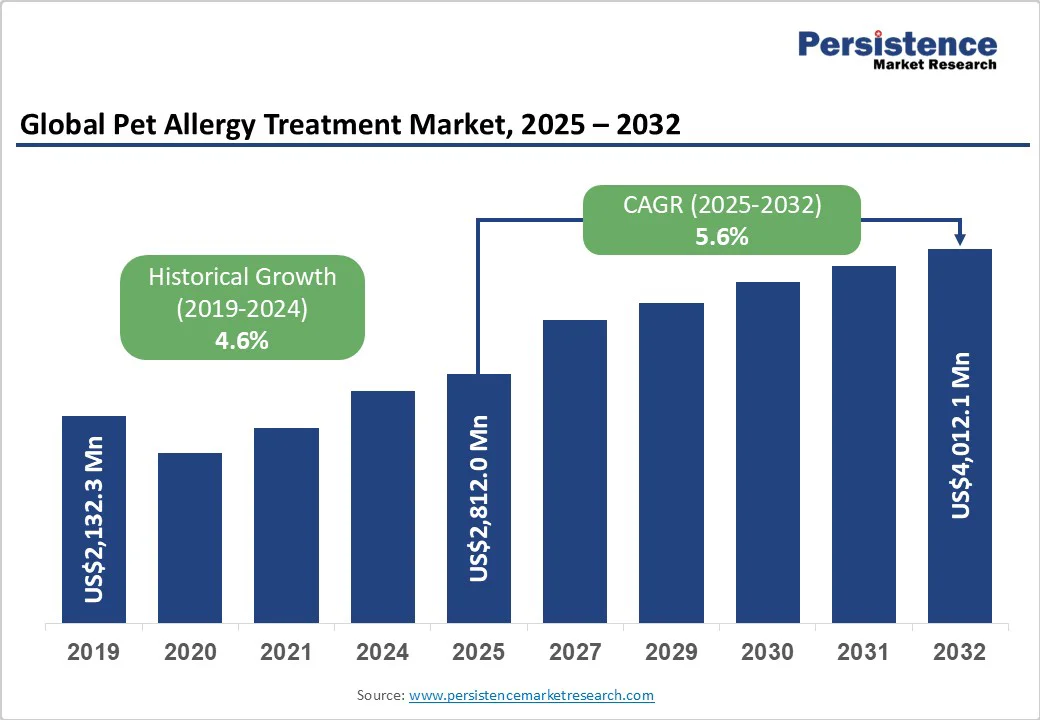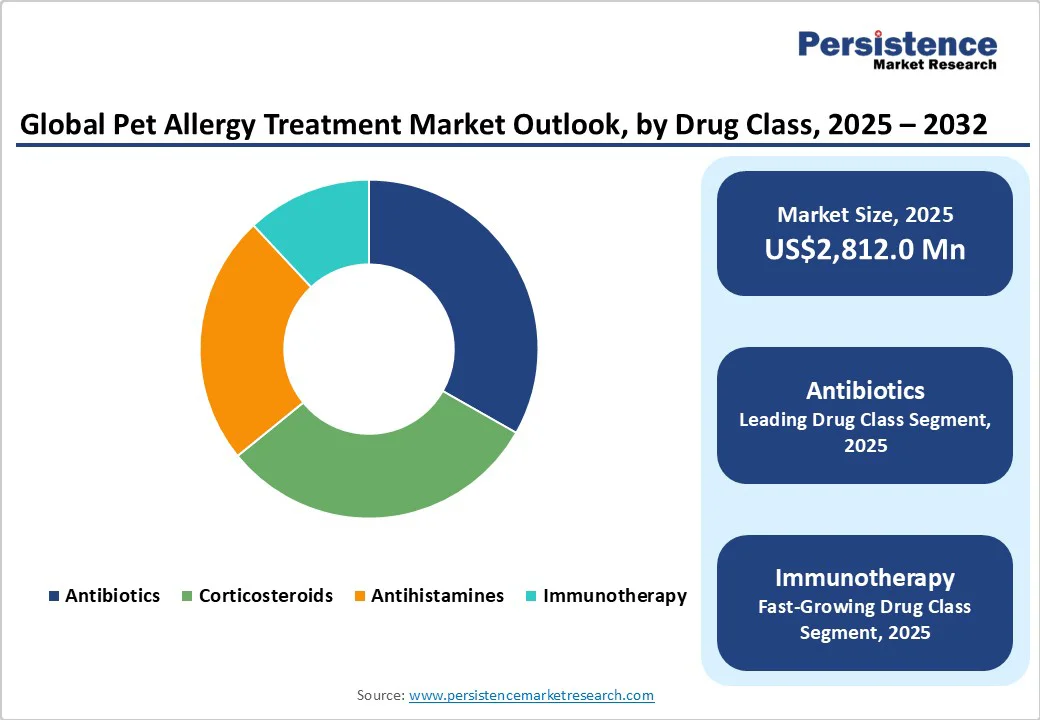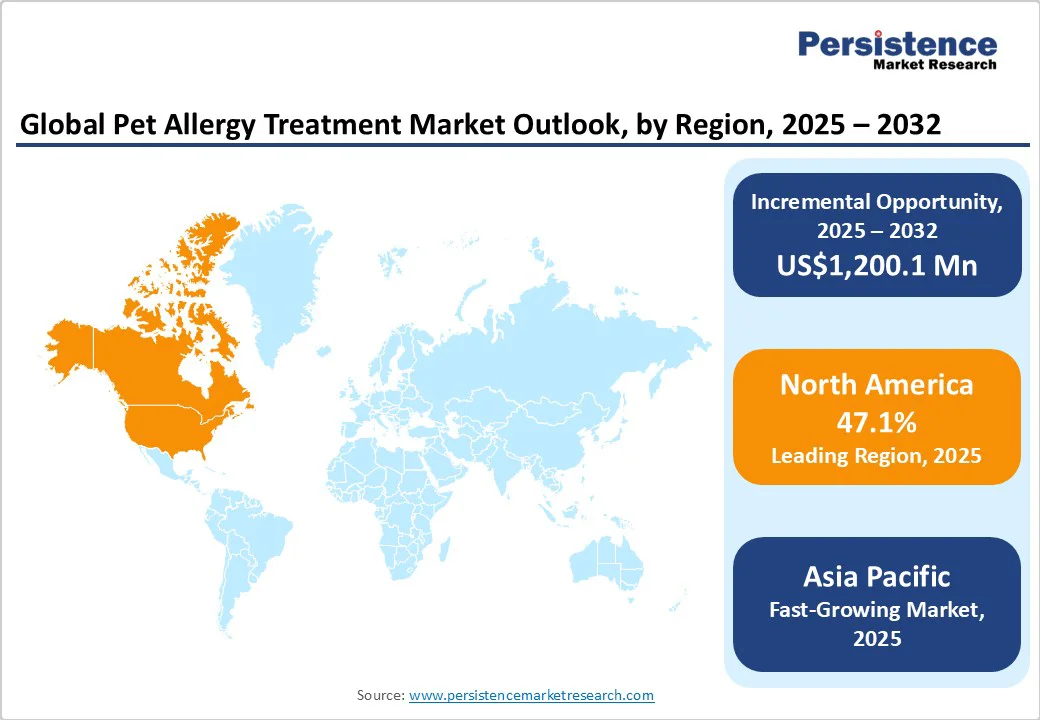ID: PMRREP28603| 191 Pages | 27 Sep 2025 | Format: PDF, Excel, PPT* | Healthcare

The global pet allergy treatment market size is likely to be valued at US$2,812.0 Mn in 2025. It is expected to reach US$4,012.1 Mn by 2032, growing at a CAGR of 5.6% during the forecast period from 2025 to 2032, driven by the increasing pet adoption, rising awareness of animal healthcare, and owners’ willingness to spend on premium treatments. The market adopts a multifaceted approach, focusing on enhancing animal health and owner satisfaction.
| Key Insights | Details |
|---|---|
|
Pet Allergy Treatment Market Size (2025E) |
US$2,812.0 Mn |
|
Market Value Forecast (2032F) |
US$4,012.1 Mn |
|
Projected Growth (CAGR 2025 to 2032) |
5.6% |
|
Historical Market Growth (CAGR 2019 to 2024) |
4.6% |

The steady rise in global pet ownership is one of the strongest drivers shaping the pet allergy treatment market. Pets are increasingly being viewed as family members, leading to higher adoption rates across both developed and emerging countries. According to the Pew Research Center, 62% of Americans own at least one pet, and 35% of them own multiple pets, reflecting the deepening bond between humans and animals. Similar trends are being observed in the U.K. and other European nations, where households are actively adopting dogs, cats, and small companion animals.
This growing pet population, while emotionally rewarding, also increases the likelihood of exposure to allergens such as dander, saliva, and urine proteins. As more people share their living spaces with pets, the prevalence of pet-related allergies is increasing, particularly in urban households. Consequently, there is a stronger demand for effective treatment options, including antihistamines, decongestants, immunotherapies, and biologics to manage symptoms and improve quality of life.
Furthermore, as pet ownership expands across younger demographics and families with children, awareness regarding allergy prevention and treatment is gaining traction. This trend is encouraging pharmaceutical players, veterinarians, and healthcare providers to introduce innovative therapies and accessible solutions, ultimately boosting market growth.
A significant restraint in the pet allergy treatment market is the underdiagnosis and misdiagnosis of symptoms. Pet allergy manifestations, such as sneezing, coughing, watery eyes, and breathing difficulties, often overlap with other respiratory conditions, including asthma, sinusitis, or seasonal allergic rhinitis.
The overlap makes it difficult for healthcare professionals and patients to correctly identify pet allergies, especially in households with multiple environmental triggers such as dust, mold, or pollen. As a result, many cases go unnoticed, and patients either remain untreated or receive inappropriate medications that fail to address the root cause. This delays the adoption of effective treatment and lowers overall demand for specialized allergy therapies, thereby restricting market growth despite increasing pet ownership rates.
Pet allergy immune supplements present a promising growth opportunity in the pet allergy treatment market, as rising pet ownership is coupled with increasing awareness of preventive health solutions. Unlike conventional treatments that focus only on symptom management, immune supplements strengthen pets’ natural defense systems, helping reduce allergic reactions from within.
With growing preference for natural, holistic, and long-term wellness approaches among pet parents, demand for supplements containing probiotics, omega fatty acids, antioxidants, and herbal extracts is accelerating. This trend is further supported by the humanization of pets, the adoption of premium products, and the expanding availability of products through online and specialty veterinary channels.
Based on drug class, antibiotics are leading the market segment by acquiring 34.8% share of the global market in 2025. Antibiotics are gaining attention across the globe due to their higher efficacy against infections and allergies, thereby being highly adopted by consumers.
Pets with allergies often suffer from some symptoms, such as ear infections or respiratory issues. In these scenarios, antibiotics play a vital role in alleviating the discomfort and preventing the infection and complications.
Dogs are expected to lead the market with a 49% share in 2025, driven by their status as the most common household pets and their higher allergenic potential. Proteins in dog dander, saliva, and urine are known to be strong allergens, frequently causing asthma, rhinitis, and skin reactions in sensitive individuals.
Dogs release allergens more frequently and in greater quantities than other pets, raising the risk of household exposure. The growing trend of dog ownership, particularly in urban areas, continues to fuel demand for allergy diagnostics and treatment. Moreover, the strong emotional connection between families and their dogs makes pet abandonment unlikely, leading owners to pursue medical solutions for allergy management, reinforcing dogs as the dominant segment in the market.

North America is projected to dominate the market with a 49% share in 2025, driven by its sizable companion animal population, high pet ownership rates, and strong awareness of pet healthcare. Pet parents are increasingly seeking advanced solutions beyond traditional antihistamines, including immunotherapy, probiotics, and immune-boosting supplements. The trend toward natural and holistic care is fueling the demand for herbal and organic formulations.
Veterinary clinics and pet specialty stores are actively promoting allergy diagnostics and personalized treatment plans. The surge in online retail channels also expands accessibility, while premiumization and the willingness to spend more on companion animal wellness continue to position North America as a key growth hub.
Asia Pacific is emerging as a high-growth region, driven by rapid urbanization, rising pet ownership, and increasing awareness of pet health. As disposable incomes grow, owners are more willing to invest in advanced treatments, shifting from basic symptom management to long-term solutions such as immunotherapy and immune-boosting supplements.
Countries such as China, India, and Southeast Asian nations are witnessing strong demand for veterinary care and specialized products. The rise of e-commerce platforms and veterinary telehealth services is enhancing accessibility. Preference for natural, herbal, and preventive solutions further positions the Asia Pacific as a dynamic and fast-evolving market.

The global pet allergy treatment market is characterized by the presence of leading pharmaceutical companies, veterinary healthcare providers, and specialized pet care brands. Key players are focusing on developing innovative therapies, including advanced immunotherapy, probiotics, and herbal-based supplements, to address the growing demand for safe and effective solutions. Strategic collaborations with veterinary clinics, research institutions, and online platforms are enhancing market reach. Companies are also investing in product diversification and regional expansion to capture emerging markets.
The pet allergy treatment market is projected to be valued at US$2,812.0 Mn in 2025.
The pet allergy treatment market is primarily driven by the rising prevalence of pet allergies among cats and dogs, coupled with the increasing humanization of pets and the willingness of owners to spend on their health.
The pet allergy treatment market is poised to witness a CAGR of 5.6% between 2025 and 2032.
Key market opportunities in the pet allergy treatment market include the rising demand for natural and holistic solutions such as herbal supplements, probiotics, and immune-boosting formulations.
The key players include Zoetis Animal Healthcare, Merck & Co., Inc., Boehringer Ingelheim GmbH, Bayer AG, and Vetoquinol S.A.
| Report Attribute | Details |
|---|---|
|
Historical Data/Actuals |
2019 - 2024 |
|
Forecast Period |
2025 - 2032 |
|
Market Analysis |
Value: US$ Mn |
|
Geographical Coverage |
|
|
Segmental Coverage |
|
|
Competitive Analysis |
|
|
Report Highlights |
|
By Drug Class
By Animal Type
By Route of Administration
By Distribution Channel
By Region
Delivery Timelines
For more information on this report and its delivery timelines please get in touch with our sales team.
About Author